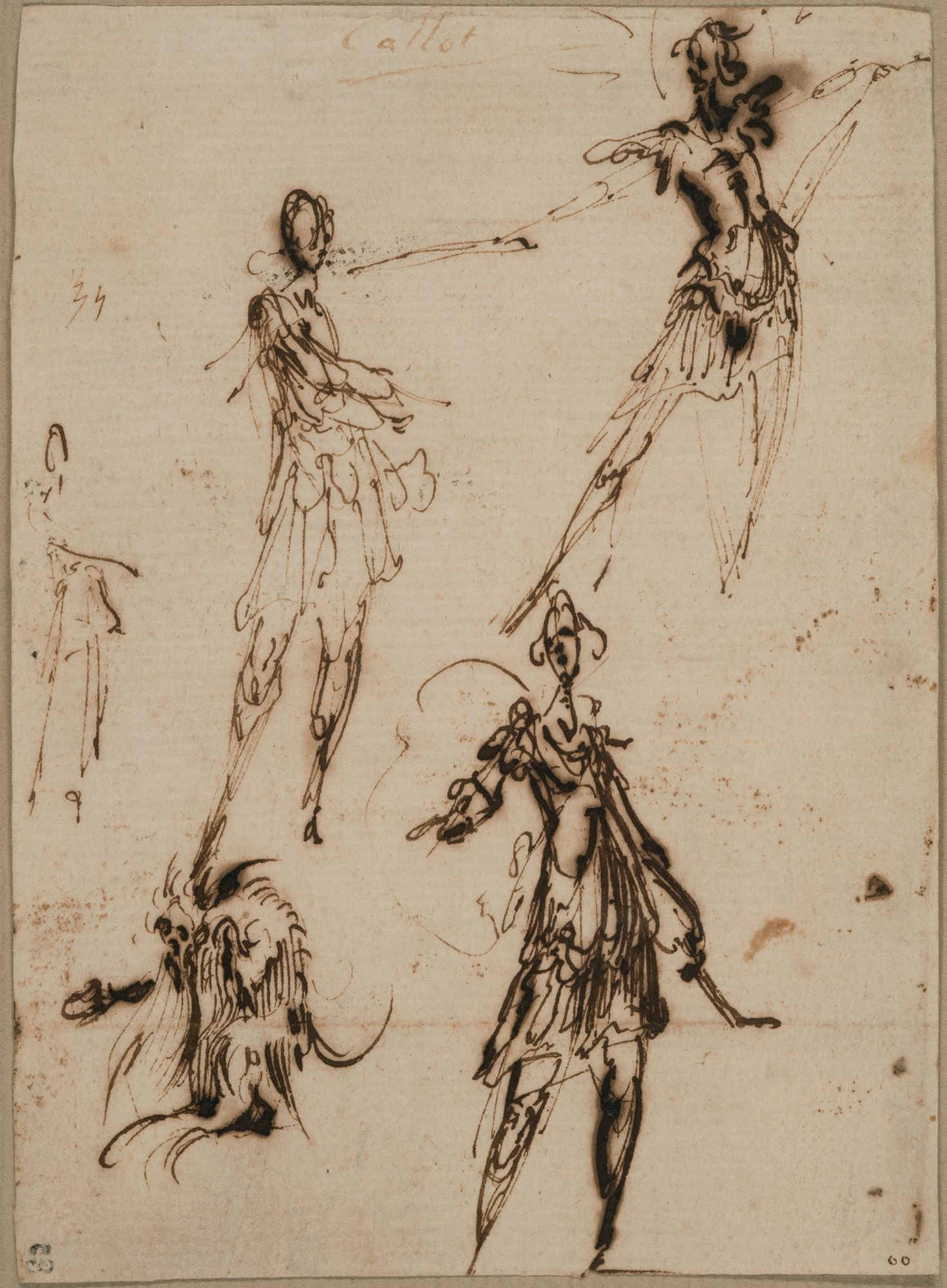FJK 014
Callot Jacques (French, Nancy 1592–1635 Nancy)
Five Sketches of Figures: Four Soldiers in Fantaisy Roman Costumes and Crouching Monkey (?)
ca. 1616
5 5/8 × 4 1/16 in. (143 × 103 mm)
Medium
Pen and brown ink on paper
Two small circles in pen bottom right
Inscription upper: Callot
Mount numbered: 92
Collector’s mark “Marquis Philippe de Chenevières” bottom left (Lugt 2073)
Origin
Marquis Philippe de Chennevières Collection, Paris and Bellesme (1820-1899)
2nd Sale Chennevières, Paris, Hôtel Drouot, April 4-7, 1900
Dr. Tuffier Collection, Paris
Gaston Delestre Collection, Paris (acquired in 1956)
Jan Krugier Collection, Monaco (acquired on May 7, 1982), JK 3477
Jan Krugier Foundation
Bibliography
CHENNEVIERES Philippe de, “Une collection de dessins, Callot,” in L’Artiste, 1894-1897, 1895, I, p. 31.
TERNOIS Daniel, Jacques Callot, Catalogue complet de son œuvre dessiné, Paris: F. de Nobele, 1962, p. 41, no. 54, ill.
TERNOIS Daniel, L’art de Jacques Callot, Paris: F. de Nobele, 1962, pp. 110-112.
TERNOIS Daniel, Jacques Callot. Catalogue de son œuvre dessiné. Supplément (1962-1998), Paris: F. de Nobele, 1999, p. 45 (“dessins de Callot ayant changé de possesseurs depuis 1962”).
DÜCKERS Alexander, Linie, Licht und Schatten, Meisterzeichnungen und Skulpturen der Sammlung Jan und Marie-Anne Krugier-Poniatowski, Berlin: G & H Verlag, 1999, Catalogue raisonné, p. 397, ill.
RYLANDS Philip, The Timeless Eye. Master Drawings from the Jan and Marie-Anne Krugier-Poniatowski Collection, Berlin: G & H Verlag, 1999, Catalogue raisonné, p. 397, ill.
Exhibitions
Paris, Gallery Claude Aubry, Dessins italiens et français du XVIe et du XVIIe siècles dans les collections privées françaises, 1971, no. 17.
Nancy, Musée historique lorrain, Jacques Callot 1592-1635, 1992, p. 170, no. 61, ill.
Madrid, Museo Thyssen-Bornemisza, Miradas sin Tiempo. Dibujos, Pinturas y Esculturas de la Coleccion Jan y Marie-Anne Krugier-Poniatowski, 2000, p. 134, no. 51, color ill. p. 135.
Paris, Musée Jacquemart-André, La Passion du Dessin. Collection Jan et Marie-Anne Krugier-Poniatowski, 2002, Addendum, no. 9, color ill.
Notes
The crouching monkey is engraved in reverse with a few modifications, in the center of the third plan in the first version of the Temptation of Saint Anthony etched by Callot in 1616-17 (Meaume, 138; Lieure, 188).
The figures in Roman costumes, especially the one pulling his sword, are related to some figures in another etching by Callot, Le Défilé, Entrée des chars de l’Afrique et de l’Asie (Meaume, 633; Lieure, 170), from the series of four pieces La Guerra d’Amore (Meaume, 620, 633-635; Lieure, 169-172). For the 1615 carnival (1616 of our calendar), Cosimo II of Medici, Grand Duke of Tuscany, ordered a celebration with ballets of simulated parade and battles take place of Santa Croce in Florence. A non-illustrated publication dedicated to the Grand Duchess by Andrea Salvadori, Guerra d’Amore Festa del Serenissimo Gran Duca di Toscana Cosimo II […], was published the same year in Florence by Zanobi Pignoni (translated into French by Lieure, Catalogue, I, pp. 62-63). Staging and choreography by Agnolo Ricci, chariots and costumes by Giulio Parigi, music by Jacopo Peri, Paolo Grezi and Giovanni Battista Signorini, under the direction of knight Giovanni del Turco. The prints by Callot and other engravers, representing the main episodes of the carnival, were folded and attached to the booklet.
The present sheet and several others prove that Callot did not merely engrave Parigi’s drawings, but took part in the invention with his usual fantasy (Ternois, 1962, nos. 10-11, 47-50, 54). With their elongated proportions and contrasted movements, these early sketches show a mannerism marked with Tuscan tradition, while the monkey illustrates another side of Callot’s genius, the burlesque.
Daniel Ternois, Miradas sin Tiempo, Madrid, Museo Thyssen-Bornemisza, 2000, p. 134 (translated from French)
Request for information/loan
The Jan Krugier Foundation is devoted to increasing the impact of the collection of drawings through regular loans to major exhibitions. Loan applications should include a complete presentation of the project.

